Vol 1 No. 25 TROPIC LIGHTNING NEWS August 19, 1966
Index
[The photographs in this issue of Tropic Lightning News were so light it was
difficult to reproduce them. They have been included only to give a sense
of the activities in the Division.]
196th Joins Div.
The 196th Light Infantry
Brigade (Separate), which landed at the South China Sea port of Vung Tau Sunday,
has been attached to the division, making the 25th the largest U.S. combat force
in Vietnam.
The brigade, the first light
infantry brigade in U.S. military history, will be located at Tay Ninh under
the command of Brig. Gen. Edward H. deSaussure Jr., former assistant
division commander (see following story).
Activated at Ft. Devens,
Mass., on Sept. 15, 1965, the 196th Bde. underwent eight months of individual
and unit training. An estimated 50
per cent of the brigade were inexperienced soldiers when they began training.
The brigade trained its men
as a unit, from basic combat training to advanced individual training through
large unit tactical operations training. Col.
Francis S. Conaty Jr., deputy brigade commander, took the brigade through the
rigorous training program.
During the latter stages of
the training program, heavy emphasis was put on counter-guerrilla, counter-insurgeney
training. To authenticate the
training, the brigade was supported by a Special Forces (A) team of Vietnam
veterans, who organized and trained teams to act as the Viet Cong during
brigade-size tactical training exercises.
Major units of the new
brigade are the 2nd Bn., 1st Inf.; 3rd Bn., 21st Inf.; 4th Bn., 31st
Inf., and the 82nd Arty. Bn.
Other units serving with the
l96th include the 8th Spt. Bn., the 175th Engr. Co. (Combat), and F Trp., 17th
Armored Cav. (See additional unit information on page 7.)
Lodge Tours Cu Chi
Henry Cabot Lodge, United
States Ambassador to Vietnam, visited Cu Chi last week to receive briefings on
the current military situation.
The ambassador, accompanied
by Maj. Gen. J. C. F. Tillson III, assistant chief of staff, J-3, Military
Assistance Command, Vietnam, and Maj. Gen. Jonathan O. Seaman, commander, II
Field Force, Vietnam, was met by Maj. Gen. Fred C. Weyand, division commander,
at Cu Chi Army Airfield.
The ambassador was honored
with a color ceremony at division headquarters and met the major unit commanders
of the division and the division General Staff.
The party was briefed by Gen. Weyand on the concept of the division’s
operations.
After Lodge left division
headquarters, he flew to Duc Hoa to review the 25th Division, Army, Republic of
Vietnam, pacification operation.
He later visited in the
field with Col. Thomas M. Tarpley, 2nd Bde. commander, and 1st Bn., 27th Inf.,
commander, Maj. Guy S. Meloy, and his staff.
The ambassador said that he
visited the Wolfhound command post because of his interest in the pacification
program there.
 |
DIGNITARY - U.S. Ambassador to Vietnam Henry Cabot Lodge is honored during color ceremonies at Cu Chi. Left to right are Maj. Gen. Fred C. Weyand, division commander, Col. Thomas W. Mellen, chief of staff, and Ambassador Lodge. (Photo by Williams) |
Former 25th ADC Becomes Bde.
CG
 Brig. Gen. Edward H.
deSaussure Jr. has assumed command of the 196th Light Inf. Bde., succeeding Col.
Francis S. Conaty Jr., who has become deputy commander of the separate brigade.
Brig. Gen. Edward H.
deSaussure Jr. has assumed command of the 196th Light Inf. Bde., succeeding Col.
Francis S. Conaty Jr., who has become deputy commander of the separate brigade.
Gen. deSaussure was
graduated from the U.S. Military Academy at West Point in 1941. He served in the Pacific in the early days of World War II
with the 4th Field Arty. Bn. and with various field artillery battalions in the
United States for the remainder of the war.
From 1947 to 1949, he
studied at Johns Hopkins University in Baltimore, Md., and received a Masters
Degree in Electrical Engineering.
From 1951 to
1953, he commanded the 20th Field Arty. Bn., with the 4th Inf. Div. in
Germany. From 1953 to 1954, he
served as group executive officer in the 30th Field Arty. Gp., also in Germany.
From 1955 to 1956, Gen.
DeSaussure was a member of the Department of the Army General Staff, and from
1956 to 1959, he served as military assistant to the deputy secretary of
defense.
He attended the Army War
College from 1959 to 1960, followed by a year of duty in Korea.
In 1961 he returned to Ft.
Sill, Kansas, where his duties included being directory of Guided Missile
Department in the Artillery School and commanding officer of the 9th
Field Artillery Missile Group. During
both of these assignments, he participated in training the Army’s Sergeant and
Pershing Missile Battalions for deployment to Europe and the Pacific.
From June 1964 to May 1965,
he served as the Army member of the Chairman’s Staff Group in the office of
the chairman of the Joint Chiefs of Staff.
Gen. DeSaussure joined the
division in May 1965 and, until he took command of the 196th, he was
assistant division commander.
Chiefs
From 25th Divisions To Join Hands
To dedicate the sharing of a
common purpose in the struggle against oppression and tyranny, the division will
host a joint ceremony of the 25th Division, Army of the Republic of Vietnam (ARVN),
25th Division, Republic of
Korea Army (ROK), and “Tropic Lightning” Division representatives at Cu Chi
tomorrow.
Starting at noon,
the ceremony will include three reviewing officers: Brig. Gen. Phan Trong
Chinh, commander of the ARVN division; Maj. Gen. Kwak Choel Jung, commander of
the ROK division, and Maj. Gen. Fred C. Weyand.
An honor guard platoon, two
color guards, two color bearers and one plaque bearer from each division also
will participate.
“The ceremony,” said Lt.
Col. Jamie L. Aiken, Tropic Lightning assistant chief of staff, “will
symbolize the brotherhood of three famous 25th Infantry Divisions from three
different countries sharing a common cause - the struggle against tyranny and
oppression.”
“The event will afford us
an opportunity to reaffirm our mutual faith in liberty and justice and to
pledge our skills, resources and endeavors to the cause of freedom for all
nations and all men.”
During the ceremony, an
inscribed plaque will be presented to each of the commanding generals.
Among the distinguished
guests invited to attend are Gen. W.C. Westmoreland, commander, United States
Military Assistance Command, Vietnam, and Gen. Dwight E. Beach, commanding
general, 8th United States Army in Korea.
The Tropic Lightning Band
will provide music for the ceremony and 25th Div.
Red
Cross Hostesses Arrive
Civilization of sorts hit Cu
Chi last week with the arrival of three Red Cross girls who plan to set up a
mobile recreation program for
division troops.
The girls, Pat McDaniels,
22, of St. Augustine, Fla., Vicky Olson, 23, of Rochester, Minn., and Shiela
Otto, 24, of Minneapolis will develop the Red Cross program to be taken from
unit to unit so that everyone will have a chance to participate. The girls will also develop a special program for use in the
base camp’s medical facilities.
Miss McDaniels, a graduate
of Florida State University, joined the Red Cross last month. After a short course on Red Cross activities in Washington,
she was sent directly to Vietnam
(See
Hostesses, Page 8)
| FEMININE PULCHRITUDE - Shiela Otto, Vicky Olson and Pat McDaniels. Red Cross recreation hostesses start to unpack and settle in their new quarters at the division base camp. The girls will conduct a mobile recreation program for division troops at Cu Chi. (Photo by Finklea) |
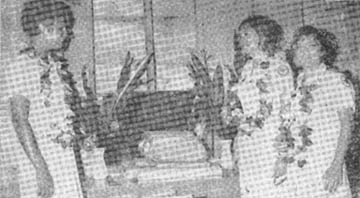 |
Page 2 TROPIC LIGHTNING NEWS August 19, 1966
Decorated
|
BRONZE STAR MEDAL WITH 'V' DEVICE |
|
|
Cpt.
Stanton L. Curbow, Hq. & Hq. Co., 1st Bn., 27th Inf. |
Sp4
Linwood W. Puryear, Co. A, 2nd Bn., 27th Inf. |
| AIR MEDAL |
|
|
Cpt.
John E. Kempster, D Trp., 3rd Sqdn., 4th Cav. |
WO
James C. Spears, D Trp., 3rd Sqdn., 4th Cav. Sp5 Dwain I. Adkins, D Trp., 3rd Sqdn., 4th Cav. Sp4 Robert B. Black, Hq.& Hq. Det., 25th Avn. Bn. Sp4 David A. Nordeen, Co. B, 25th Avn. Bn. Sp4 Harvey L. Johnson, Co. B, 2nd Bn., 27th Inf. |
|
ARMY COMMENDATION MEDAL |
|
|
Cpt. Alvin L.
Koestring, Hq. & Hq. Co., 25th S&T Bn. 1Lt. James M. McCormick, 25th Mil. Intel. Det. MSgt. John M. Howard, 25th Admin. Co. SFC Jewel Daniels, 25th Admin. Co. SFC Richard H. Swann, 25th Admin. Co. SSgt Raymond H. Frost, Co. B, 725th Maint. Bn. |
SSgt.
Eugene O. Heins, Hq. & Hq. Co., 25th S&T Bn. SSgt. Howard E. Sanford, 25th MP Co. Sgt James C. Baker, Co. A, 25th S&T Bn. Sp4 Robert A. Algeri, Hq. & Hq. Co., 1st Bn., 27th Inf. Sp4 Earl L. Spangler, Btry. A, 1st Bn., 8th Arty. Sp4 James B. Wardein, Hq. & Co. A, 25th Med. Bn. |
 |
TREAT - Capt. William J. Frank of Grand Junction, Colo., a division dentist, treats a villager from the village of Tan An Hoi during one of the regular Medical Civic Action Program (MEDCAP) visits there. (Photo by Finklea) |
Aid
Began With Ike
The roots of support and aid
to South Vietnam go back as far as 19 years
when former President Eisenhower vowed to offer help to then President
Ngo Dinh Diem.
The commitment to Vietnam
has deepened as the threat to the country’s
autonomy has increased.
It was on Dec. 14, 1961,
that President Kennedy, in a letter to President Diem, reaffirmed the United
States’ position to assist Vietnam in retaining its freedom. He wrote:
“Dear Mr. President:
“I have received your
recent letter in which you described so cogently the dangerous condition caused
by North Vietnam’s efforts to take over your country.
The situation in your embattled country
is well known to me
and to the American people. We have
been deeply disturbed by the assault on your country.
Our indignation has mounted as the deliberate savagery of the Communist
program of assassination, kidnapping and wanton violence became clear.
“Your letter underlines
what our own information has convincingly shown - that the campaign of force and
terror now being waged against your people and your government is supported and
directed from the outside by the authorities at Hanoi.
They have thus violated the provisions of the Geneva Accords, designed to
ensure peace in Vietnam and to which they bound themselves in 1954.
“At that time the United
States, although not a party to the Accords, declared that it would view any
renewal of the aggression in violation of the agreements with grave concern and
as seriously threatening international peace and security.
We continue to maintain that view.
:In accordance with that
declaration, and in response to your request, we are prepared to help the
Republic of Vietnam to protect its people and to preserve its independence.
We shall promptly increase our assistance to your defense effort as well
as help relieve the destruction of the floods which you describe.
I have already given the orders to get these programs underway.
“The United States, like
the Republic of Vietnam, remains devoted to the cause of peace and our primary
purpose is to help your people maintain their independence.
If the Communist authorities in North Vietnam will stop their campaign to
destroy the Republic of Vietnam, the measures we are taking to assist your
defense efforts will no longer be necessary.
We shall seek to persuade the Communists to give up their attempts of
force and subversion. In any ease,
we are confident that the Vietnamese people will preserve their independence and
gain the peace and prosperity for which they have fought so hard and so long.”
Protection
Attacking military personnel
might become a federal offense under a resolution Rep. Glenn Andrews ( R-Ala.)
intends to introduce into the House of Representatives.
The congressman cited a need for such legislation after the recent attack
and robbery of a serviceman aboard a subway train in Chicago. (AFNB)
Why
Does Everything Cost So Much In The Saigon-Cholon Area?
As an American in Vietnam
your income is generally higher than even the top-paying Vietnamese positions.
Even a PFC in the U.S. Army receives more on payday than some field grade
officers in the Vietnamese Army.
This higher income does not
give us the careless right to pay higher prices for everything and toss our
money around in a display of wealth, at the same time demanding privileged
treatment.
We are here to aid the
Vietnamese people, not damage their economy.
By paying more you not only hurt your fellow soldier, but you promote
inflation, making it possible for the Vietnamese people to afford the basic
necessities such as transportation and food.
The TROPIC LIGHTNING NEWS is an authorized publication of the 25th Infantry Division. It is published weekly for all division units in the Republic of Vietnam by the Information Office, 25th Infantry Division, APO U.S. Forces 96225. Army News Features, Army Photo Features, Armed Forces Press Service and Armed Forces News Bureau material are used. Views and opinions expressed are not necessarily those of the Department of the Army. Printed in Saigon, Vietnam by Saigon Daily News.
Maj.Gen. Fred C. Weyand . . . . . . . Commanding General
Maj. William C. Shepard . . . . . . . . . Information Officer
1st Lt. William H. Seely III . . . . . . . Officer-in-Charge
SP5 Dale P. Kemery . . . . . . . . . . . . . Editor
SP4 David L. Kleinberg . . . . . . . . . Editorial Assistant
Page 3 TROPIC LIGHTNING NEWS August 19, 1966
Chaplain
Errico Calls ‘All’ to Alter
Cartoonist Bill Mauldin’s
World War II drawing depicted a chaplain standing on a battle-scarred field,
ministering to his men. The caption
read, “In the name of the Father, the Son and the Holy Ghost. Amen. Hit the
dirt”
It is just such a life that
Chaplain (Maj.) Maurice J. Errico of Marlboro, Mass., has faced during two wars
and 13 years in the Army.
In assuming duties as
assistant division chaplain recently, Chaplain Errico returned to a job he left
to become 25th Div. Arty. chaplain a year and a half ago.
A volunteer for service when
a call went out for priests near the end of the Korean War, Chaplain Errico
busily moves around Hau Nghia Province carrying out his dedicated duty,
frequently with the same impromptu surroundings and vestments cartoonist Mauldin
depicted.
And the chaplain’s work is
heedless of race or color.
Recently, he was in the
field saying mass for an artillery unit near Trung Lap.
During the mass he noticed that there was a young Vietnamese officer in
the group.
When the service was
finished the Vietnamese approached shyly and thanked the priest for letting him
attend the service. Then the
soldier mentioned that the Army, Republic of Vietnam (ARVN), unit at Trung Lap
had not heard a mass for more than six months.
In spite of a busy schedule
the chaplain said he just couldn’t pass up the request.
Chaplain Errico cleared the
service with U.S. advisors in the area and then asked what time would be best
for the mass. The Vietnamese
lieutenant said 45 minutes would be plenty of time for them to set up a chapel.
A half hour later, the
chaplain walked into a schoolroom he had been told would serve as the chapel to
prepare for the mass.
He had expected to find 25
or 30 soldiers. Instead, there were
almost 100 in clean uniforms and spit-shined boots.
Their caps off and heads bowed, the men were quietly waiting for the
service to begin.
As he moved to the front of
the room, he saw the altar. It was
a rickety old table, covered with an immaculate white cloth. On either side
there was a small candle, and the front of the room was decked with flowers.
The young lieutenant
appeared and asked in a soft voice if the chaplain would mind too much if some
of the women and children came to mass, too.
Chaplain Errico said he would be delighted if everyone came.
In minutes, the room was
crowded with almost 200 Vietnamese soldiers and their families, waiting to hear
their first mass in six months.
Father Errico began, “I
will go to the alter of God…”
‘H
& I’ Blasts V.C., Bothers Cu Chi
It’s hard to get to sleep
at Cu Chi some nights.
The thundering artillery
rounds keep hammering away at the Viet Cong until it seems, as many troops would
testify, the howitzers are in the tent kits.
They’re not, but that
still doesn’t stop the men, even those asleep, from jumping every time a round
goes off. It’s almost an
unconscious reaction.
At times the horizon is as
bright as though the sun were shining, or it may look like someone celebrating
the 4th of July on the wrong day.
Almost apologetically, 25th
Div. Arty. offers this explanation: The
nightly activity is harassment and interdiction (H&I).
H&I is a program
intended to deny the Viet Cong freedom of movement and also to limit the area
the enemy may use as an operational zone.
On an average night, some
1000 to 1500 rounds from 105mm, 155mm, 8-inch howitzers and 175mm guns go
whistling out of the base camp.
Div. Arty. Reports that as
many as 45 Viet Cong have been killed in one night’s barrage.
While they may not always
get enough sleep, Cu Chi’s troops realize with H&I they have a much better
chance of waking up.
Commissions
For Nurses
Male nurse legislation
before Congress would authorize regular Army and Air Force commissions to this
personnel category previously restricted to reserve commissions.
The bill being heard by a House armed services sub-committee also would
authorize male nurses to serve as chief or assistant chief of nurses. (AFNB)
Palm
Trees
Cu
Chi Goes Pretty
The Cu Chi base camp gets
better looking every day.
The latest beautification
took place when 6 palm trees were recently planted along Lightning Loop, home of
the division’s general staff.
Obtained by Capt. Roy B.
Gemberling of Millburn, N.J.,
administrative assistant to the chief of staff, these palm trees serve as
reminders of the division’s former Hawaii home.
Capt. Gemberling dug up the
trees at the nearby village of Tan An Hoi and trucked them to their planting
site. They were planted with the
assistance of Maj. Frank S. Farmer of Mokuleia Beach, Hawaii, the headquarters
commandant, and several other men from the staff offices.
Forming a square in front of
the general staff offices, the palms will be a substitute for Schofield
Barracks’ rows of palms, according to Lt. Col. Jamie L. Aiken of Raleigh,
N.C., assistant division
chief of staff.
“Three months ago there
was nothing here,” said Col. Aiken. “Now,
these palms seem to form the only oasis at Cu Chi.”
Twenty-two more palms are
scheduled to be planted during this month, 11 on each side of the palm square.
| WITH REVERENCE - Chaplain (Maj.) Lawrence R. Rast delivers the Call to Worshtlp for the first memorial service in the 3rd Sqdn., 4th Cav., chapel. Seated (l to r) are Lt. Col. John R. Hendry, 3/4 Cav. commander., Maj Gen Fred C. Weyand, division commander, and Maj. Albert L. Russell, squadron executive officer. (Photo by Park) |  |
3/4
Cav. Dedicates New Chapel
The officers and men of 3rd
Sqdn., 4th Cav., recently held a dedication service for their newly built
memorial chapel.
The chapel, which took more
than two months to build, was designed by Sp4 Robert D. Stephens of Babylon,
N.Y. It is made of brick and has a
small bell which has been in the unit since World War II.
CWO Cecil B. Anderson of
Shawnee, Okla., was the project officer for construction of the chapel.
The men paid for all materials used and supplied the labor.
The chapel was dedicated to
the men who lost their lives in Vietnam.
Viet
Support Uses ‘Red Ball Super’
The process of rushing
combat supplies to frontline soldiers, known as the “Red Ball Express” in
World War II, has been succeeded by what might be called the “Red Ball Super
Express,” a more advanced and complex system.
With the space age’s
technological advances, supplies now come roaring down the tracks at a speed
unheard of in World War II - a fact that members of the 725th Maint. Bn. at Cu
Chi would be the first to admit.
The battalion, responsible
for having enough parts to enable the forward support companies and main support
company to perform third echelon maintenance, gets a new shipment of supplies
daily, both via air and land from Saigon.
The 725th consists of five
companies. Headquarters and Co. A
is the main support unit in the battalion.
All equipment which cannot
be repaired at the forward support companies is taken to Hq. and Co. A.
Companies B and C: are the
forward support companies. Co. E is
the aircraft maintenance company.
Page 4-5 TROPIC LIGHTNING NEWS August 19, 1966
25th LOOKS FOR ACTION
| REFLECTION – Members of the 2nd Bn., 14th Inf., cross water-filled rice paddies during a recent search-and-destroy mission. |
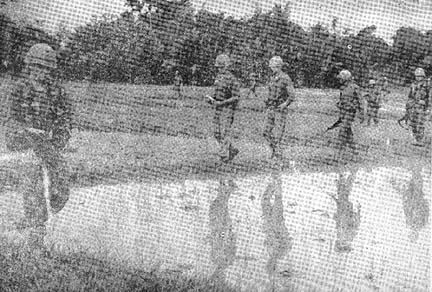 |
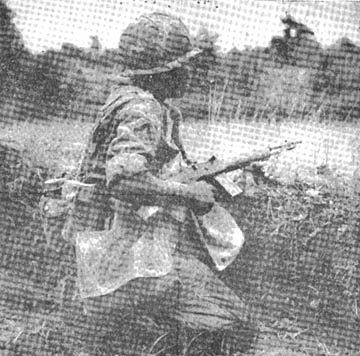 |
ALONE – A lone soldier from the division seeks out the enemy in the Ho Bo Woods on Operation “Koko Head”. (Photo by Pardue) |
| SUPPORT – A gunship gives support to division elements on a combat assault mission. (Photo by Shibla) |  |
| START – Infantrymen are airlifted into the Ho Bo Woods on Operation “Koko Head”. (Photo by Stachera) |  |
 |
WATCH – Members of Co. A, 1st Bn., 27th Inf., search a house during Operation “Ewa,” 25 miles southwest of Cu Chi as 1st Sgt. Leonard L. Letoto of Waipahu, Hawaii, keeps a watch. (Photo by Earl) |
When
Contact Is Made
Medics Rush In For Quick Evac
 The men of the division go
out looking for action and sometimes run into some they don’t expect.
The men of the division go
out looking for action and sometimes run into some they don’t expect.
But in Vietnam, when a man
goes down, he is not down long. Immediately
the medics are by his side. He is
treated and evacuated, sometimes in speeds unheard of in World War II and Korea.
On the right, medics work
only 100 feet from the battle area in the Boi Loi Woods. Sp5 Gerald Snyder of Walla Walla, Wash., begins an
intravenous “intracath” procedure on an unidentified wounded infantryman.
Assisting Snyder, who
received a Bronze Star Medal for his work under fire, is Sp5 Dennis Ortman of
Cleveland.
Below, PFC Paul Widtfeldt
(r) of Council Bluffs, Iowa, carries an unidentified wounded infantryman out of
the Boi Loi Woods, maneuvering a litter down the narrow jungle path.
Medic Widtfeldt, who does not carry a weapon, fills the extra space by
stuffing dozens of extra first-aid dressings in his aid bag.
(Photos by Hirsh)
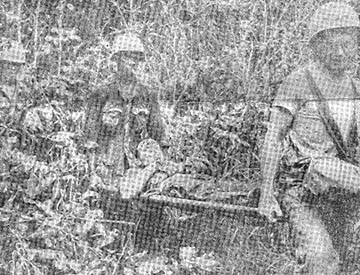
Page 6 TROPIC LIGHTNING NEWS August 19, 1966
‘Ft.
Fritts’ Takes VC Mortars
Viet Cong mortar rounds
recently pounded a concentrated area at the division base camp and, when the
smoke cleared, ‘Fort Fritts’ still stood.
Fort Fritts, the nickname
tacked to the 25th MP Co.’s area at the base camp because of its fort-like
fortifications, came through the barrage with only minor damages and minor
casualties.
Commanded by Capt Courtney R. Fritts of Devon, Pa., the company built
33 sandbag bunkers in preparation for just such an attack.
“The men of the company
did a lot of complaining when we built the bunkers,” said Capt. Fritts.
“Although I explained how handy the sandbags would be during an attack,
the danger of a shelling at the base camp seemed far off. After the attack,
though, they voluntarily began filling more sandbags to make the bunkers
stronger.”
As the bunkers stand, the
captain feels that a direct hit would pose little problem. Each bunker is strengthened by a frame of four-by-eight,
four-by-four and two-by-four timbers.
The
smaller of the company’s bunkers - 12 feet long, eight feet wide and
five feet high - have at least 2000 sandbags placed in a neat double thickness
on all four sides and on the roof.
Each squad tent in the area
is equipped with two of the smaller bunkers, and a four-foot wall made of
another 4000 sandbags surrounds each tent to protect men who are sleeping when a mortar strikes.
A total of 2096 feet of wall
surrounds the company’s tents.
Larger command bunkers - 12
feet long, eight feet wide and 12 feet high - are located outside the
company’s command offices and are equipped with telephone lines to the bunker;
where squad leaders are located. All
of the bunkers contain caches of ammunition.
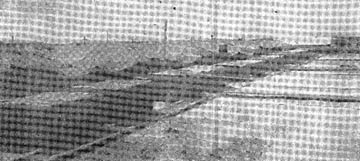 |
A MIGHTY FORTRESS—This neat row of bunkers along one side of “Fort Fritts” is equipped with extra ammunition, first-aid supplies and communication systems. |
 |
IMPREGNABLE - Two of “Fort Fritts” larger command bunkers lend an indestructible appearance to the 25th MP Co.’s orderly room. Removable sandbags fit into the bunker gun ports to keep the fortification metal-tight during attacks. |
Election
News |
Chaplain’s
Assistant Conducts One-Man Civic Action Program
Sp4 Robert G. Rebman, 3rd
Bde. chaplain’s assistant, is conducting his own civic action program.
Since June 1, Specialist
Rebman, acting as intermediary for his hometown of Lancaster, Pa., has delivered
more than 30 packages of soap, clothing, shoes and medicine to the Vietnamese
children attending Pleiku Elementary School.
Rebman first
came in contact with the school children when he delivered chaplains’
vestments to the school’s nuns, who wash and iron them. The sisters operate
the non-denominational school and teach all the classes.
“When I first went there,
most of the children were barefoot and wore rags. They had sores on their bodies
and lice in their hair. They were
shoeless in the rainy season, and came down with colds, pneumonia and worse,”
Rebman said.
“I had heard of other
civic action programs and felt the people of my hometown could and would want to
help. So I wrote to the Lancaster
newspapers explaining the situation and asked that all inquiries be referred to
my parents, who live there. Responses
to that letter are still coming in!”
“The 30 boxes of clothes,
shoes, soap and medical supplies have made a big difference at the school.
Now the kids come to school more often and the 14 nuns can devote more
time to teaching.
“A little bit has made a
big improvement, but there’s still a long way to go.
“Men from the 4th
Personnel Support Team and I will continue to visit those kids as long as
we’re here - if just to say, ‘Hi!’”
VC
Hit ‘Reup’ Sign
“The VC must not want us
here,” said SFC Clarence N. Eddie of Hopkinsville, Ky., a re-enlistment NCO
for the division, as he pointed to a large hole in the Army ‘re-up’ sign
outside his office.
Fragments from an 82mm
mortar round had hit the sign during a recent mortar attack on the Cu Chi base
camp. Some believe that the Viet
Cong, knowing of the division’s steadily increasing re-enlistment figures,
pinpointed one of their rounds and successfully knocked out the sign.
Despite Viet Cong mortar
accuracy in sign destruction, the men of the 25th have continued to enlist.
More than 20 re-enlistments have been recorded since the incident.
Page 7 TROPIC LIGHTNING NEWS August 19, 1966
The 196th Infantry Brigade
2nd
Battalion 1st Infantry ‘Guardians’
Organized in 1791, 1st Inf.
was to provide protection from frontier Indians after the British left America.
The 1st participated in the War of 1812, the Mexican War and, upon
returning to the frontiers and the Indian Wars, the unit became known as
“Guardian of the Frontier.” In
the Civil War, Gen. Robert E. Lee, Ulysses S. Grant and .Zachary Taylor served
in the 1st, as did Jefferson Davis, who later became president of the
Confederacy. The 1st also fought in
the Spanish-.American War and served in the Philippines.
In World War II, the 1st fought in the battles of Lone Tree Hill and
Rocky Point, and took. part in the struggles for Luzon and Bataan.
The 1st Inf. motto is “Semper Primus - Always First.”
82nd
Arty. Battalion
The 82nd Arty.
Was founded during World I. In
1921, it was assigned to the 1st Cav. Div.
The unit supported the 7th and 8th Cav. On the
Mexican border against the rampages of Pancho Villa. The 1st Cav. And the 82nd Arty, were
stationed at Ft. Bliss, Tex., until 1943, when they headed for Pacific combat.
After World War II, the 82nd provided occupational support in Japan,
until 1950, when called into the Korean War.
3rd
Battalion 21st Infantry
Organized by proclamation of
President Lincoln in 1862, 21st Inf. earned 11 battle streamers in
the Civil War. The unit
participated in the fighting at Fredericksburg, Chancellorsville, Spotsylvania,
Cold Harbor and Petersburg. After
the Civil War the 3rd Bn. maintained peace in the southwest frontier. Next came the Spanish-American War and the Moro Insurrection
in the Philippines. In 1921, the
21st Infantry joined the Hawaiian Division.
The unit remained in Hawaii and became part of the 24th Inf. Div. when it
was organized in 1941. In 1944, the
regiment went ashore in New Guinea, followed by the invasion of the Philippines.
After the war came
occupational duty in Japan, then two tours in Korea during the Korean Conflict.
The motto of the Gimlets is “Duty.”
Other units from 21st Inf. have served with the “Tropic Lightning”
Division, the last having left the division in 1963 under the reorganization of
the Army’s combat divisions.
4th
Battalion 31st Infantry ‘Polar Bears’
Organized at Regan Barracks,
Camp McGrath and Ft. William McKinley in the Philippine Islands in 1916, the
regiment served in the Siberian campaign during the Russian Revolution in 1917,
and in 1920 returned to Manila. The “Polar Bears” saw action in the Korean
War, including the battles of Heartbreak Ridge and Pork Chop Hill.
The motto of the 31st Inf. is “Pro Patria…For Country.”
Col.
Walker Promoted
Col. Aaron E. Walker was
recently promoted to his present rank in a brief ceremony at 25th Div. Arty.
headquarters. The silver
eagle was pinned to his collar by Col. Daniel B. Williams, Div. Arty. commander.
Col. Walker is the Div.
Arty. executive officer (XO), a position he assumed on July 15, 1966.
The colonel’s first eagle
was given to him by 3rd Bn., 13th Arty., where he was commanding
officer for more than a year before his assignment as Div. Arty. XO.
Called up with the 45th Inf.
Div. in September 1950, Col. Walker served in Korea for a year as regimental
intelligence officer. He also saw
service in the European Theater during World War II.
Col. Walker of Ada, Okla.,
was originally in the infantry. He
accepted a regular Army commission in 1958, when he traded his crossed rifles
for artillery cannons.
The colonel holds a Masters
Degree in Economics from the University of Alabama.
His Army training includes attendance at the School of Advanced Infantry
and Command and General Staff College.
 |
SALUTE – Col. Aaron E. Walker ® is saluted by his commanding officer, Col. Daniel B. Williams, after being promoted to his present rank. (Photo by Finklea) |
Help
to VN
At the present time, 34 Free
World countries are providing - and several more have agreed to provide –
assistance to South Vietnam. Negotiations
are underway between the Government of Vietnam and many of these nations for
additional aid.
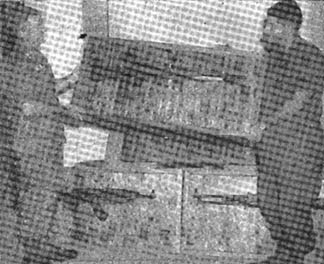 |
TROPHIES – Maj. Gen. Stanley R. Larsen (l), commanding general, I Field Force, Vietnam, is presented four captured weapons by Sgt. Michael Horowitz. The weapons were captured by 3rd Bde. on various field operations. (Photo by Walker) |
| ...AND SOUVENIRS - Brig. Gen. Glenn D Walker (r), 3rd Bde. Task Force commander, presents a communist rifle to Maj. Gen. Keith L. Ware, chief of information, Department of the Army, during Gen. Ware’s visit to the 3rd Bde. forward command post. (Photo by Martensi) |  |
Page 8 TROPIC LIGHTNING NEWS August 19, 1966
All-Out
Effort
Wounded
GIs Still Get Mail
“I think that mail from
home is the most important thing there is to a soldier in Vietnam,” said Sgt.
Donald L. Baker, beginning his fourth week in the 93rd Evacuation Hospital at
Bien Hoa. He is recovering from
wounds inflicted by two grenades hurled at him during a Viet Cong ambush.
Then, the Waterloo, Iowa,
squad leader from Co. A, 1st Bn., 27th Inf., tore into the first of three
letters brought to him that evening by the division’s Hospital Mail Call
program.
The mail call program,
serving division troops in seven Army hospitals located in South Vietnam, is a
seven-day-a-week, 12-hour-a-day job
for hospital mail clerk PFC Alfred J. Coppola Jr., from Harrison, N.Y.
Coppola, a buoyant,
fast-talking 20-year-old, makes daily visits to two of the seven hospitals - the
93rd and the 3rd Surgical and supervises the delivery of mail to the other five.
His first stop on the visits
is the Admission and Disposition (A and D) Office of each hospital, where he
checks on new admissions, discharges and transfers.
After administrative details are out of the way, he walks through the
wards, stopping to visit with each soldier along his route.
Exchanging conversation for
requests from the soldiers, Coppola promises to call individual units, to check
mail rosters and to do anything else he can to eliminate a patient’s problems.
Returning from the hospitals
at 4 p.m. every day., Coppola begins checking out A and D sheets against locator
cards kept on the patients. Once he
has determined the location of each person, he gets in touch with unit mail
clerks to bring records up to date.
Beginning again the
following morning at eight o’clock, Coppola picks up mail taken to the
division’s post office by unit mail clerks and begins the morning-long job of
sorting.
After seeing that mail for
five of the hospitals is loaded on trucks and on its way, Coppola hops on a
helicopter and heads for his route.
“Although being hospital
mail clerk for the whole division is more than a full-time job,” Coppola said,
“I like my work and want to see that it gets done right.”
And the patients in the
hospitals are as enthusiastic about seeing Coppola as he is about his job.
“Whether there is mail for a 25th division soldier or
not,” said Capt. William Ryan, hospitalized commander of the 9th
Chemical Detachment attached to the division.
“Coppola stops to say hello and bring news.
That in itself is mail.”
C/S
Presents Awards
Bronco
Capt., SP5 Receive Silver Stars
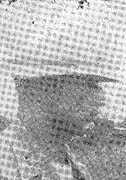 Capt. James R. Maisano and
SP5 Roy Bean were awarded Silver Stars Medals, the Army’s third highest award
for valor, by Gen. Harold K. Johnson, Army chief of staff in recent ceremonies
at 3rd Bde.
Capt. James R. Maisano and
SP5 Roy Bean were awarded Silver Stars Medals, the Army’s third highest award
for valor, by Gen. Harold K. Johnson, Army chief of staff in recent ceremonies
at 3rd Bde.
Gen. Johnson was visiting
the forward command post on an assessment tour of Vietnam.
Capt. Maisano’s award was
for gallantry in action while serving as commanding officer of Co. B., 2nd Bn.,
35th Inf., during a heliborne assault.
Immediately upon deployment
from the aircraft on the initial lift into the landing zone, his unit was
partially pinned down by intense enemy fire.
By successfully controlling his maneuver element and building fire
superiority, Capt. Maisano overcame the initial Viet Cong resistance.
He then organized and
maintained assaults to re-open the landing zone and allow the remainder of the
unit to be landed. Although the company perimeter
was repeatedly attacked by successive waves of more than two battalions of enemy
troops, he held his sector.
 Specialist Bean was awarded
his Silver Star for service as a medic with Co. C, 1st Bn., 69th Armor, while
the unit was on a search-and-destroy mission.
Specialist Bean was awarded
his Silver Star for service as a medic with Co. C, 1st Bn., 69th Armor, while
the unit was on a search-and-destroy mission.
The company entered a small
rice paddy between two dense wood lines and was attacked by an estimated
reinforced company, which was using automatic weapons and grenades at
point-blank range from well-fortified bunkers and tunnels.
The tank commander of the lead tank was severely wounded from the initial
burst of fire. Ignoring the
intense automatic weapons fire directed at the tank, Specialist Bean ran to the
beleaguered tank, administered first aid to the wounded officer, removed him
from the tank and, while shielding him with his own body, helped him to the aid
station for evacuation.
Surgery
The Army’s surgeon general
says one of the most encouraging war surgery stories comes from Letterman Gen.
Hospital in San Francisco, where a mortar fragment was removed from a heart of a
young infantryman wounded in Vietnam. Rapid
helicopter evacuation and “artificial heart machines” in forward combat
areas make such operations possible for the first time in the history of
warfare. (AFNB)
Red
Cross Hostesses
(From Page 1)
and the division.
Miss Olson came to the
division from Camp Humphries, Korea. A
sociology major from the University of Minnesota, she has been with the Red
Cross for almost two years.
The veteran of the group is
University of Nebraska graduate Shiela Otto, who has been working for the Red
Cross for two years. Her last
assignment was with 1st Bde., 101st Abn. Div., at Phan Rang, Vietnam.
The three Red Cross workers
arrived by helicopter at the Cu Chi Army Airstrip and were escorted to division
headquarters, where they were welcomed with leis by Maj. Gen. Fred C. Weyand,
division commander.
The Red Cross Recreation
Program began in Korea in 1953 at the request of Gen. Douglas MacArthur to
provide activities which will promote the serviceman’s participation and new
interests, recreation and fun and while keeping the serviceman in touch with
home.
The program began in Vietnam
in June 1965. Presently there are
63 girls in-country serving with 14 different
units.
Presidential
Advisor Visits Division Camp
Professor Henry Kissinger,
personal advisor to President Johnson, visited the division base camp last week
as part of his tour of U.S. military installations in Vietnam.
The purpose of the
professor’s visit was to hold informal discussions on military operations and
pacification activities.
Kissinger met with Division
Commander Maj. Gen. Fred C. Weyand and members of his staff. He also visited the “Helping Hand” Operations Center.
Richard Teare of the
American Embassy Political Section in Saigon and a Military Assistance Command,
Vietnam, representative accompanied Kissinger on his tour.
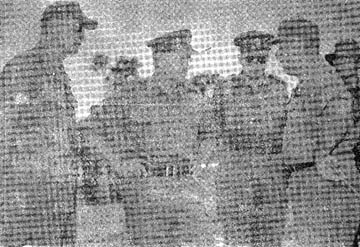 |
AUSSIE BOSS - Lt. Col. Robert R. Hicks (r), division G-5 (Civil Affairs), discusses the Helping Hand Operation Center with Maj. Gen. D. Vincent, commander, 1st Australian Division, Australian Forces, Vietnam. Division Commander Maj. Gen. Fred C. Weyand looks on. (Photo by Finklea) |
Thanks to
Robert Dixson, 4th Bn., 9th Inf. (Manchus) for sharing this issue,
Ron Leonard, 25th Aviation Bn. for locating and mailing it,
Kirk Ramsey, 2nd Bn., 14th Inf. for creating this page.
This page last modified 8-12-2004
©2004 25th Infantry Division Association. All rights reserved.